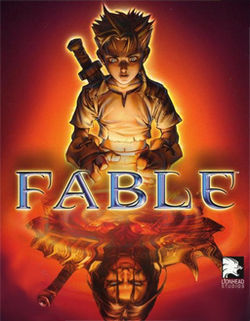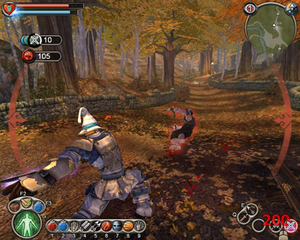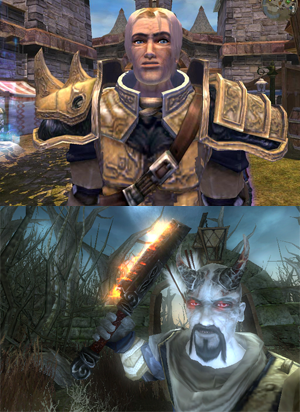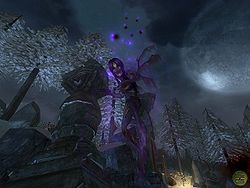On November 27th, 2022, the 8,000th article was added to the SuccuWiki!
Succubus Queen (Fable)
For other uses of the word Succubus, see Succubus (disambiguation).
Fable is an actionrole-playing video game in the Fable (video game series) franchise. It was developed for Xbox, Mac OS X, and Windows platforms, by Big Blue Box, a satellite developer of Lionhead Studios, and was published by Microsoft. The game shipped for Xbox on September 14, 2004. An extended version of the game, Fable: The Lost Chapters, was released for Windows and Xbox in September 2005; Feral Interactive ported the game to the Mac platform on March 31, 2008, & Robosoft Technologies created the platform after a delay of more than two years due to licensing issues.
Originally developed under the name Project Ego, Fable's development involved more than seventy people. The game's music was composed by Russell Shaw, with the opening title theme written by Oscar-nominated composer Danny Elfman. The game's release was widely anticipated, due in part to Lionhead creator Peter Molyneux's enthusiastic hype of the game.
Fable was well-received by critics for the quality of its gameplay and execution, though the failure to include many promised features was noted. Aside from critical acclaim, Fable was the top-selling game of September 2004 and sold more than two million units by 2007. Due to its popularity, the game has spawned several sequels, and by the autumn of 2010, the game franchise will have reached three installments, thus forming a trilogy.
In the extended version of the game, Fable: The Lost Chapters, there is a character called the Succubus Queen whom meeting and fighting is a rare event.
Game Information
- Title: Fable
- Developer(s): Lionhead Studios, Big Blue Box, Robosoft Technologies (Mac)
- Publisher(s): Microsoft Game Studios, Feral Interactive (Mac)
- Designer(s): Peter Molyneux
- Composer(s): Danny Elfman, Russell Shaw
- Series: Fable (video game series)
- Engine: RenderWare
- Platform(s): Microsoft Windows, Mac OS X, Xbox
- Release date(s):
- Xbox: September 14, 2004
- Windows: September 20, 2005
- Mac: March 31, 2008
- Genre(s): Action RPG, sandbox
- Mode(s): Single player
- Rating(s): ESRB: M, OFLC: M (original rating) MA15+ ('Lost chapters' rerating), PEGI: 16+
- Media: DVD
Setting
Fable takes place in the fictional world of Albion. Players assume the role of an orphaned boy who realizes his dream of becoming a hero. The choices players make in the game affect the perception and reaction to their Hero by the characters of Albion, and change the Hero's appearance to mirror what good or evil deeds the Hero has performed. In addition to undertaking quests to learn what happened to the Hero's family, players can engage in optional quests and pursuits such as trading, romance, boxing, pub gaming, betting and theft.
Gameplay
Fable is a role playing game where players control their character from a third person perspective. The main character, known as the Hero, can interact with people and objects as well as battle foes. The goal of Fable is to complete missions known as quests which advance the game's plot, but Fable also features optional quests and allows players to pursue actions not directly tied to game completion.[1]
Most quests are undertaken at a central location, known as the Heroes' Guild; required quests are marked with a gold symbol and advance the game's story, while optional quests are colored silver and can be completed in any order. Some quests allow players to pick sides and aid either evil characters, such as bandits, or good characters, such as traders and guardsmen. Players can also boast after accepting a quest, wagering some of the quest's reward gold in exchange for a larger return if the player accomplishes their bet, such as sustaining no damage or undertaking the quest naked. Each quest's completion gives players gold, which can be used to buy weapons and items, and renown, which affects the way townspeople react to the Hero. Heroes also earn trophies of their victories, which can be displayed to large groups of townspeople to earn more renown.
In addition to fighting with melee weapons (such as swords and maces) and ranged weapons (longbows and crossbows), Heroes can learn and use spells to augment their abilities, ward off damage, or harm foes. A Hero's spells and attributes can be leveled via experience orbs gained from killing enemies and completing quests. Experience points earned have four categories: General, Strength, Skill, and Will. General points are gained through completion of quests and killing enemies and creatures, while dealing damage by hand, by using a ranged weapon, or by using spells earns more strength, skill, and will points, respectively. The experience the main character gains can be multiplied during combat through the combat multiplier. As the character successfully hits an enemy, his combat multiplier increases. If the character is hit by the enemy, the combat multiplier drops down to the next multiple of five, or zero if below five.
Fable's game world is dotted with towns where recreational activities not related to combat can be undertaken. Enterprising Heroes can buy trade items such as beer kegs or grain sacks and sell them at other towns for profit. Towns are also prime locations to buy clothing, weapons, or other items. Many towns have houses for sale, which the Hero can buy, furnish, or lease to tenants for gold. Heroes may woo and marry men or women in each town, and through sufficient courting engage in sexual intercourse with them.
Alignment
In Fable, a player's Hero has a measure of good or evil alignment based on the Hero's actions. Good deeds award good points, which produce a positive alignment, while committing evil acts adds evil points, producing a negative alignment. Killing monsters or saving villagers are acts of goods, whereas killing innocents, breaking laws, or abusing a spouse will accumulate evil points. Consuming certain foodstuffs can also affect the Hero's alignment; for example, eating tofu will earn the hero positive points, while eating crunchy chicks (because crunchy chicks are still alive) will earn evil points. The alignment affects not only the responses of non-player characters around the Hero, but also the appearance of the Hero himself. A Hero with a strongly positive alignment will feature a halo and a shaft of sparkling light above his head, butterflies fluttering around him and lighter features. An evil Hero emits a red haze from around his legs, draws flies, has glowing red eyes and grows horns.
Other actions besides alignment affect the Hero. Eating too much causes the character to gain weight, while drinking excessive amounts of beer causes Heroes to become sick and vomit. Clothing, which provides defense in combat situations, also changes the Hero's attractiveness or scariness as well as alignment in some cases, and townspeople's reactions to the Hero accordingly. Bright clothing makes the character look more noble to the townspeople, and thus cause them to praise and respect him. Dark clothing causes the character to seem evil or threatening to townspeople and cause them to fear him. Heroes can be further customized via hairstyles, facial hair, and tattoos. The Hero's attributes also affect appearance; high levels of Strength increase brawn, high levels of skill increase height, and high level spells create glowing arcane patterns on the Hero's body.[2]
Synopsis
Setting
Fable takes place in Albion, a patchwork of city-states with lawless stretches of plains and forest between them. Once called the Old Kingdom, the entire land was once led by an ancient royal bloodline, bestowed with the title of Archon. The first Archon's rule was peaceful and prosperous but the source of his power was an ancient and powerful sword that gradually began to corrupt him and, eventually, his entire kingdom. By the time the events of the game take place, the world has slowly deteriorated from the days of the Old Kingdom. One of the most prominent institutions of Albion is the Heroes' Guild. The Guild is a center of learning and training for Heroes, renowned mercenaries that are active in all parts of Albion. Heroes are hired as thieves, soldiers, guards, rescuers, and protectors; the Guild makes no moral judgment on the actions of its Heroes. Guild members learn melee and ranged combat, as well as a form of magic known as Will.
Plot
When the Hero is a child, his village, Oakvale, is raided and destroyed by bandits on his sister's birthday; it seems the Hero's entire family perishes. An old hero named Maze arrives on the scene, rescues the Hero, and convinces him to join the Heroes' Guild to be trained to become a champion; Maze sees great potential in the boy. The Hero then embarks on a journey to discover the reason behind his village's destruction, discovering his destiny, and the true fate of his family along the way.
After a time, and after honing his skills, Maze informs the Hero of a blind seeress living among a bandit camp near Oakvale, and advises the Hero to infiltrate the bandit camp. To the Hero's surprise, the blind seeress is actually his older sister who was taken in by Twinblade, a former Hero and the present Bandit King. After a showdown with Twinblade, the Hero is given the choice of killing or sparing Twinblade.
Later on in the Hero's life, after he has gained more recognition among the people of Albion, he is invited to fight in the Arena, where he meets the legendary Hero named Jack of Blades, who is running the arena battles and, as a final show, issues a challenge against the Hero and his rival and friend Whisper. When the Hero defeats her, he is given the choice kill her or to spare her life.
It eventually becomes clear that it was Jack of Blades himself who hired the Hero's mentor Maze to destroy the Hero's home. Aided by his blind sister, the Hero makes it his mission to defeat Jack of Blades one way or another, either through good or evil. The Hero tracks down his mother, and attempts to rescue her from Bargate Prison, where Jack has kept her since the day of the Oakvale raid. However, the Hero is captured and spends a year or more in the prison. When he finally escapes with his mother, the Hero attempts to track down Jack. Maze, however, turns against the hero and kidnaps his sister. After defeating Maze, the Hero is led into a final confrontation with Jack where his mother is killed. After defeating him, the hero must choose whether to keep the Sword of Aeons that Jack sought by killing his sister, or cast it away forever into a portal created by Jack of Blades' death. Depending on the Hero's alignment and the player's choice of using or destroying the sword, there are a total of four different endings. Once the ending credits roll, players can resume their games.[3]
In The Lost Chapters special edition, the story continues. After the defeat of Jack, the Hero must find passage to the Northern Wastes to aid a legendary hero named Scythe in stopping an unknown great evil from returning. After a series of quests revolving around this new evil, it is learned Jack of Blades has returned. He must then defeat Jack of Blades a second time, as he has returned from the dead in the form of a dragon. Upon the permanent death of Jack, his mask falls to the ground, and the Hero is given the choice to put it on and become the ultimate evil, or throw it into the lava below and destroy it.
Development
Fable was the first game developed by Big Blue Box, a satellite studio of Peter Molyneux's Lionhead Studios. Dene and Simon Carter, Big Blue Box's founders, stated that their first project would have to meet several criteria in order to be accepted by game publishers, but that they weren't interested in producing such a generic title.[4] To offset the costs of running a fledgling studio, Molyneux proposed Lionhead 'satellites', where Big Blue Box would receive the technology and support of Lionhead so that Big Blue Box could focus on making the game.[4] After some difficulty in finding a willing publisher, Big Blue Box was contacted by Microsoft who offered a contract for their game. According to the Carters, they wanted to create a roleplaying game like no other:
The world would be a breathtakingly beautiful place filled with waterfalls, mountains, dense forests, populated with compelling and convincing characters with real personality, people who actually reacted to what you did. We wanted to give the player control of a hero who would adapt to the way they played, who would age, become scarred in battle, who could get tattoos, wear dreadlocks and a dress if the player was so inclined. We wanted each and every person who played our game to have a unique experience, to have their own stories to tell. And we called it 'Thingy.'[4]
Early in Fable's development, the game was called Project Ego.[5]
The game took roughly four years to create, with a team of around 70 developers working on it.[6] The main ideas that constituted the entire development of Fable were that the hero visually reflects his experience and that the world reacts in a manner appropriate to the player's actions.[7]
Peter Molyneux aggressively promoted Fable, at one point stating that "It's gonna be the best game ever."[8]
Fable previews noted that the somewhat absurd humor and atmosphere of the game, which GamePro called "Terry Pratchet or Piers Anthony fantasy" was far different than what was seen on contemporary RPGs.[9]
With the exception of the title theme, Fable's music was composed by Russell Shaw, who had previously worked on Molyneux games such as Magic Carpet and Black & White. The job for composing Fable's theme music was given to Danny Elfman.[10] Elfman noted in an interview that Hollywood composers did not typically cross over to video game work, in part because many game developers wanted a synthesized score that sounds like an orchestra, instead of the real thing.[11] At Elfman's insistence, the developers used a small orchestra,[11] which Shaw noted was much more of a challenge than previous projects; "There are more people involved (even without considering the orchestra), and the complexities of any music interactivity are brought to the fore."[12]
Fable: The Lost Chapters
Fable was expanded and rereleased as Fable: The Lost Chapters for Xbox and Windows PC platforms in September 2005. The game was later ported to Mac OS X by Feral Interactive on March 31, 2008.[13]
The Lost Chapters features all the content found in the original Fable, as well as additional new content such as new monsters, weapons, alignment based spells, items, armor, towns, buildings, and expressions, as well as the ability to give children objects. The story receives further augmentation in the form of nine new areas and sixteen additional quests. Characters such as Briar Rose and Scythe, who played only minor roles in the original game, are now given more importance and are included in certain main and side quests. Other character-based augmentations include the antagonist, Jack of Blades' voice sounding deeper, harsher and more demonic; and being able to uncover (and resolve) the murder mystery behind Lady Grey's sister.
The Succubus Queen
Succubi with the volume turned up to eleven. Related to the Nymphs of mainland Albion, though many have found them more resilient. Their death is not brought about easily. They are able to conjure up what local people call Wraiths, though many scholars prefer the term Hoar Skeleton. The succubus queen is far more powerful, resilient and downright irritating than any of the mainland nymphs, having spent generations isolated from all but the most hardy of Snowspire traders, honing her powers of infuriation to perfection. In addition to throwing magical projectiles at wandering heroes, she is able to summon ice horde warriors to do her bidding, making her a daunting adversary.
The succubus queen is purple in the game to distinguish her from the other Nymphs in the game. She is a creature of the North in the game as well, therefore she will be found in those regions only. Unless you have moderately low renown, these enemies will not appear often. They are found in the northern wastes.
She will appear in the Necropolis, and an Ice Troll(s) will spawn at Archon's Shrine. There is a specific criteria that triggers the Succubus Queen's appearance and it has nothing to do with Renown, time of day, or how fast you arrived in the Northern Wastes.
Succubus Nymph
Nymphs are flying enemies that can summon obstacles and enemies. There are 3 kinds. The Wood Nymph (green), the lake Nymph (blue) and the Succubus Nymph (red), the Succubus Nymph being the most powerful of these save for the Succubus Queen.
References
- ↑ Loe, Casey (2004). Fable: PRIMA Official Guide. "Fundamentals - Training: Quests". United States of America: Random House. pp. 4–6. ISBN 0-7615-4179-9.
- ↑ http://www.macworld.com/article/133900/2008/06/fabletlc.html
- ↑ Loe, Casey (2004). Fable: PRIMA Official Guide. "Chapter 4 - Stop Jack of Blades". United States of America: Random House. p. 97. ISBN 0-7615-4179-9.
- ↑ 4.0 4.1 4.2 http://www.lionhead.com/fable/fable_devdiary_01.aspx
- ↑ http://www.lionhead.com/fable/fable_devdiary_05.aspx
- ↑ http://www.usatoday.com/tech/products/games/2004-09-29-fable-review_x.htm
- ↑ http://www.lionhead.com/fable/fable_devdiary_08.aspx
- ↑ http://www.computerandvideogames.com/article.php?id=90363
- ↑ http://www.gamepro.com/microsoft/xbox/games/previews/30105.shtml
- ↑ http://xbox.ign.com/articles/500/500033p1.html
- ↑ 11.0 11.1 http://www.1up.com/do/previewPage?cId=3133731&did=1
- ↑ http://www.music4games.net/Features_Display.aspx?id=17
- ↑ http://www.feralinteractive.com/?section=news&id=220&language=english



